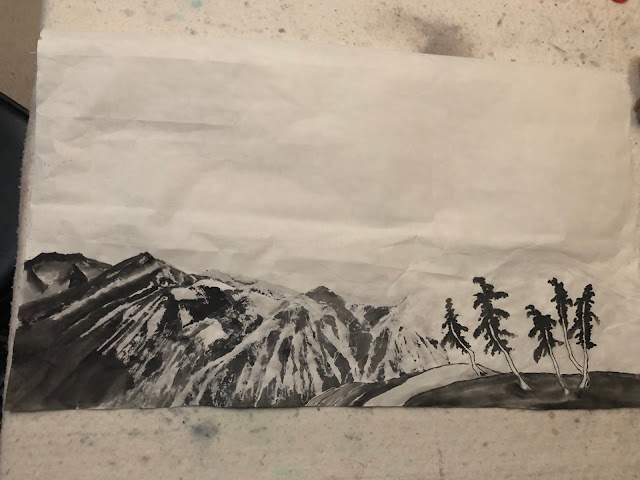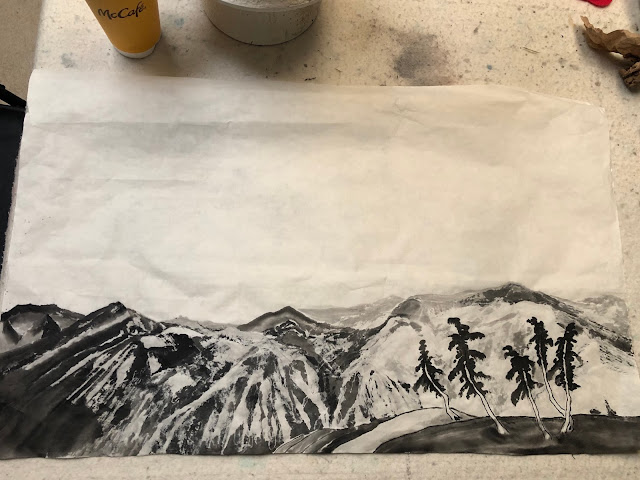Taking another look at what I've got so far. Trying to see it from the point of view of a spectator and improve anything that doesn't make sense.
As my painting involves a snow scene and the fact that I am playing with alum solution, I must find areas in the painting that I can accentuate the feeling of snow. One of such places is the lone tree in the snow field. By darkening the areas around the horizontal branches, I bring out the contrast between the ink and the spots painted with alum.
I pick out strategically located conifers and go over them partially with darker ink. Since the original footprint was done on the back of the paper, this add on ink from the top side creates a subtle effect of shadows and adds thickness to the object.
I must confess, this is a lot of fun, meeting the challenge of finding new ways to express with ink.
It is time to describe the foreground, the snow field. I had laid down a few lines to divide up the flat space when I painted on the back of the paper, so it is merely a matter to make some sense out of those lines.
Using a bigger brush, I use a very light ink to paint in the areas in the shade. Bearing in mind constantly that the brightest area, or line, is the high part of the field where it catches light. The dark lines that I painted before effectively defined the contours and undulations of the otherwise flat piece of white.
The plain expanse of white is transformed to the banks of a creek, drawing attention to the mountain in the yonder.
When dried,
I place my surplus frame over my unmounted painting. I am just eager to see what it looks like
It seems to me that the sky and the snow are too close in values, so I need to make the sky darker. After all the snow should be white, right?
As I lap on a darker tone of ink the sky, some previously alum painted tree branches emerge. This shows how nicely the alum solution worked. It is apparent that I was overzealous in my original planning, I had the trees taller than the present setup.
Now I think this is a little easier on the eye.
I recall a piece I did some years ago
I did this piece in a class that I taught. I was showing my students how to employ the Lotus Leaf chuen technique. I wanted my students to think outside the box, the fact that a classical Chinese brush landscape technique may be utilized in a non-traditional fashion. I borrowed the effect of contrast to create the illusion of a protruding snowy peak. The very dark background and the highlight patch on the flank of the peak made a stunning visual effect, albeit a technically much simpler piece done hurriedly in class as a demonstration.
It is interesting, and retrospective, to compare the 2 pieces of a snowy peak. For me, it seemed much easier to define with color; perhaps it is the way we are hardwired to do. It seems a more direct circuit for our brain to process color information as it relates to objects, thus emotions and consciousness. The color piece that was done in a matter of minutes without too much effort carries as much drama as the black and white piece that I labored for days and weeks, at first sight anyways. Perhaps this is a statement for the merits of spontaneity and extemporaneous creations, yet the black and white painting harbors so much more information. It is like an onion with so many layers to peel off. To truly appreciate it, one must read it like a book; sentence by sentence, page after page; hence brushstroke by brushstroke.










BW_9x18.jpeg)












































